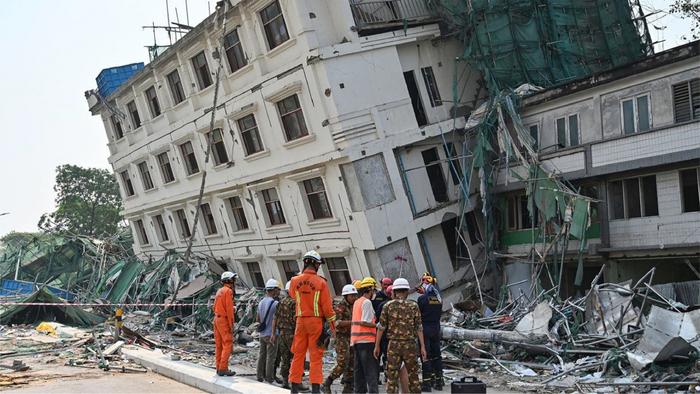Earthquake Preparedness in Myanmar: Lessons from 2025
In 2025, Myanmar was jolted by a series of moderate-to-severe earthquakes that highlighted the nation’s vulnerability to seismic disasters. While the loss of life was limited compared to past catastrophes, the year served as a crucial wake-up call for communities, local governments, and aid organizations. These events have underlined the urgent need for improved earthquake preparedness, particularly in a country with aging infrastructure, limited emergency services, and fragile governance due to ongoing conflict.
Myanmar’s Seismic Risk
Myanmar lies along the Sagaing Fault, a major continental transform fault that runs through the heart of the country, including key urban centers like Mandalay, Sagaing, and even parts of Yangon. It is one of the most seismically active areas in Southeast Asia.
Notable past quakes include:
1930 Bago Earthquake (Magnitude 7.3)
2016 Chauk Earthquake (Magnitude 6.8), which damaged ancient temples in Bagan and affected multiple regions
In 2025, a series of tremors—ranging from magnitude 5.2 to 6.3—struck near the central region and along the western border with India and Bangladesh, raising alarm due to shallow epicenters and proximity to dense populations.
Key Lessons from 2025
1. Urban Vulnerability
In cities like Mandalay and Yangon, many residential buildings are poorly constructed or not up to seismic standards. The 2025 earthquakes caused:
Cracks in older apartment buildings
Minor collapses in unreinforced structures
Panic and injuries due to falling debris
The tremors highlighted the lack of building codes enforcement, especially in informal housing settlements.
2. Rural Risk and Isolation
In remote areas of Chin State, Sagaing, and Kachin, landslides and collapsed bridges cut off villages for days. Relief operations were slowed due to:
Inaccessible roads
Poor mobile communication coverage
Limited pre-positioned emergency supplies
These challenges revealed how rural populations are disproportionately at risk, often without even basic awareness of what to do during an earthquake.
3. Emergency Response Gaps
While civil society and youth groups mobilized quickly, the official response was disjointed:
No national-level earthquake response plan was activated.
Local emergency services lacked training and equipment.
Public communication was confusing, with rumors spreading faster than official advisories.
This demonstrated the urgent need for a centralized, well-funded disaster response mechanism in coordination with state and ethnic administrations.
4. Public Awareness Still Low
Interviews and field reports from 2025 show that:
Many citizens were unsure of what to do during shaking (e.g., whether to run outside or "drop, cover, and hold on").
Schools lacked evacuation drills.
Few households had emergency kits or family preparedness plans.
Steps Forward: Building Resilience
1. Strengthening Early Warning Systems
Myanmar must invest in seismic monitoring stations and public alert systems (e.g., mobile alerts or sirens) to warn communities seconds before strong shaking begins—critical in urban centers.
2. Enforcing Safer Building Practices
Adopting and enforcing earthquake-resistant building codes—especially in new developments—is vital. Community workshops for masons and local builders can help reduce unsafe construction.
3. Education and Public Drills
Nationwide earthquake drills, school safety programs, and media campaigns should be launched. Myanmar’s youth networks and civil society can play a major role in leading grassroots awareness efforts.
4. Localized Emergency Planning
Disaster preparedness should be decentralized, with each region developing:
Risk maps
Response protocols
Local volunteer teams (trained in first aid, rescue, and coordination)
This is especially crucial in ethnic regions where state services are weak or absent.
5. International Support and Partnerships
Myanmar can collaborate with:
ASEAN’s disaster preparedness framework
UN agencies (like UNDP and UNDRR)
Regional earthquake-prone countries such as Nepal or Indonesia for knowledge exchange
The earthquakes of 2025 were not the worst Myanmar has seen, but they offered a crucial opportunity to rethink preparedness. With active fault lines running beneath its cities and countryside, Myanmar must act decisively to build resilience—not only through infrastructure, but through community engagement, public education, and stronger governance. Earthquakes don’t have to become disasters—if the right lessons are learned and acted upon.
Thank you for reading! Visit us anytime at Myanmar.com for more insights and updates about Myanmar

 A Month After the Earthquake, Thousands in Myanmar Remain Unassisted
A Month After the Earthquake, Thousands in Myanmar Remain Unassisted
 Myanmar’s earthquake death toll rises to 3,770
Myanmar’s earthquake death toll rises to 3,770
 The Earthquake Offers ASEAN a Chance to Rethink Its Humanitarian Strategy in Myanmar
The Earthquake Offers ASEAN a Chance to Rethink Its Humanitarian Strategy in Myanmar
 International Call to Free Jailed Journalist in Myanmar
International Call to Free Jailed Journalist in Myanmar
 Myanmar auction once again draws no bidders for ousted leader Suu Kyi’s historic residence.
Myanmar auction once again draws no bidders for ousted leader Suu Kyi’s historic residence.
 2 Million More Myanmar Residents Now in Need of Humanitarian Assistance
2 Million More Myanmar Residents Now in Need of Humanitarian Assistance
